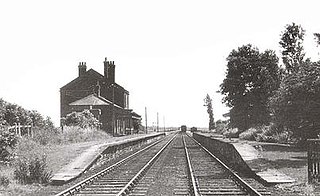
The Lancashire and Yorkshire Railway (L&YR) was a major British railway company before the 1923 Grouping. It was incorporated in 1847 from an amalgamation of several existing railways. It was the third-largest railway system based in northern England.

Great Altcar is a village and civil parish in West Lancashire, England, close to Formby on the West Lancashire Coastal Plain. The population as taken at the 2011 census was 213. The name Altcar is Norse meaning "marsh by the Alt". The church of St Michael and All Angels is a timber framed structure dating from 1879.

The Liverpool, Crosby and Southport Railway (LC&SR) received parliamentary authorization on 2 July 1847 and opened between Southport and Liverpool, on 24 July 1848. The Liverpool terminal was a temporary station on the viaduct passing near to Waterloo Goods station.

The Liverpool and Bury Railway was formed in 1845 and opened on 28 November 1848. The line ran from Liverpool Exchange first using a joint line with Liverpool, Ormskirk and Preston Railway before branching off to proceed via Kirkby then Wigan and Bolton to Bury.

Southport railway station serves the town of Southport, Merseyside, England. The station is the terminal of the Southport branch of the Northern Line of the electric Merseyrail network and the diesel-operated Manchester-Southport Line. It is the fourth busiest station on the Merseyrail network. The station and services to Liverpool and Hunts Cross are operated by Merseyrail, with Manchester services operated by Northern Trains.

Meols Cop railway station serves the Blowick suburb of the coastal town of Southport, Merseyside, England. The station has an island platform and is served by Northern Trains‘ Manchester Victoria/Manchester Piccadilly - Southport via Wigan Wallgate branch services, on which it is the last stop before the terminus.
The West Lancashire Railway (WLR) ran northeast from Southport to Preston in northwest England.

The North Mersey Branch (NMB) is a railway line that connected the Liverpool and Bury Railway at Fazakerley Junction with North Mersey and Alexandra Docks.

Southport Lord Street was a railway station located on Lord Street, Southport, Merseyside, England. It was the terminus of the Southport & Cheshire Lines Extension Railway from Liverpool.

Altcar and Hillhouse was a railway station located on the Southport & Cheshire Lines Extension Railway near Great Altcar, Lancashire, England.

Barton was a railway station in the village of Barton, Lancashire, on the Liverpool, Southport and Preston Junction Railway. Situated to the south of the roadbridge on Station Road, the station opened on 1 November 1887, and was renamed Downholland on 2 June 1924. Downholland largely served as the terminus for trains coming from Southport, though through trains to Altcar and Hillhouse operated until 1926. The Barton Branch was notable for the "Altcar Bob" service, introduced in July 1906.

Shirdley Hill was a railway station in the village of Shirdley Hill, Lancashire, on the Liverpool, Southport and Preston Junction Railway. Situated on Renacres Lane, the station opened on 1 November 1887 and was the only station on the Barton Branch to have a level crossing instead of a road bridge. The "Altcar Bob" service operated through Shirdley Hill from July 1906.
Crossens railway station was a railway station serving Crossens, a suburb of Southport, Sefton, Merseyside, England.

St Luke's railway station was a railway station in Southport, Merseyside.

The Kirkby Branch Line is a branch railway line from Wigan to Kirkby. The line's original route was from Liverpool to Bury and later the most northern of the Liverpool to Manchester lines. The line was split at Kirkby in 1977 with the western section forming a high frequency branch of the electrified Merseyrail Northern Line, also referred to as the Kirkby branch line. The Kirkby branch to Wigan remained a low frequency diesel operated service by Northern Trains from Kirkby to Manchester.
Southport Central was a railway station in Southport, Lancashire, England.
Southport Ash Street was a railway station in Southport, Lancashire, England.
The Altcar Bob was a train service introduced in July 1906 by the Lancashire and Yorkshire Railway on the Barton Branch of the Liverpool, Southport and Preston Junction Railway. The service was so named because it terminated at Altcar and Hillhouse, though from 1926 it only went as far as Barton. The Bob was a diminutive steam railmotor: a locomotive attached to a single coach. The coach was supported by only a single bogie at one end, and the locomotive at the other. Remote controls located at the rear of the coach meant that the vehicle did not require turning.
The Lancashire and Yorkshire Railway (L&YR) operated two classes of twenty steam railmotors in total.














